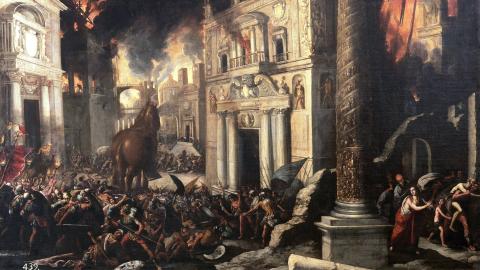Spanning more than 3,000 years, the civilisation of Ancient Egypt was not only the longest lasting civilisation in human history but also one of the most influential; leaving a lasting impact on many other cultures and societies that came after it.
Following on from the time known as Prehistoric Egypt, the civilisation began with the unification of the Lower Nile Valley under one ruler, King Menes in c.3100 BC and continued until the death of Cleopatra VII in 30 BC, when Egypt fell to the Roman Empire.
In between these dates, historians group the periods into three kingdoms known as the Old, Middle and New, which are then interspersed with years of instability called the Intermediate Periods. It was during the time of the New Kingdom (c.1550-1069 BC) when the Ancient Egyptian civilisation reached the peak of its powers.
Located in the Nile Valley, in northeast Africa, the civilisation exploited the rich and fertile lands along the banks of the river Nile. Through the invention of irrigation techniques, the Egyptians learnt to control the flow of the water. This enabled them to cultivate vast surpluses of crops, which could then support a denser populace. With an abundance of food, cultural and social developments flourished, leading to the creation of some of the most recognisable symbols of the Ancient Egyptian world.
Through innovations in quarrying and construction techniques, the Egyptians were able to create enormous pyramids, temples and obelisks. Examples included The Great Pyramids of Giza and the Great Sphinx, the former requiring 20,000 skilled labourers (not slaves) and 2.3 million limestone and granite blocks.
The pyramids served many purposes; they were a place of worship and sacrifice, they were astronomical tools and perhaps most famously, they were tombs for kings of the Old and Middle Kingdoms.
The boy king, Tutankhamen, reigned and died in the New Kingdom, a time when all rulers bar one were buried in rock-cut tombs in the Valley of the Kings, a burial site on the west bank of the Nile.
The Ancient Egyptians believed in immortality after death, which was achieved through elaborate burial practices. Famously these customs involved preserving the body by mummification, burial ceremonies and adorning the deceased with goods they could use in the afterlife.
These goods, as well as the paintings decorating the walls of the tombs, have enabled us to learn so much about their culture. The Ancient Egyptians were also one of the first societies to develop systems for writing, hieroglyphics being an example of one such system. As such, historians have been able to grasp a good understanding of daily life for an Ancient Egyptian.
With an economy based on agriculture, the majority of people were farmers, however their produce was the property of the Pharaoh, temple or noble family that owned the land. Artists and craftsmen were of slightly higher status than farmers, whilst the upper class were formed of scribes and officials, outranked only by the royal family and the Pharaoh.
The Pharaoh was the religious and political ruler of the Ancient Egyptians. Their rule was based on the divine right of the kings, meaning they were not subject to ‘earthly authority, deriving the right to rule directly from the will of the Gods.’ In the eyes of the Egyptians, the Pharaohs linked the two realms, embodying the powers of a god on earth.
Many gods and goddesses were worshipped, including Amun, the king of the gods; Horus, the god of war; Ra, the sun god; and Isis, the goddess of magic and wisdom. The importance of each of these gods in Egyptian society changed over time, often reflecting the political fortunes of the different temples.
As well as their advancement of various construction and irrigation techniques, the Ancient Egyptians also invented a system of mathematics, the plough, the first planked boats and toothpaste. They also effectively practised medicine and science, and they even implemented a calendar. Impressive, considering their life expectancy was just 35 for a man and 30 for a woman!
















